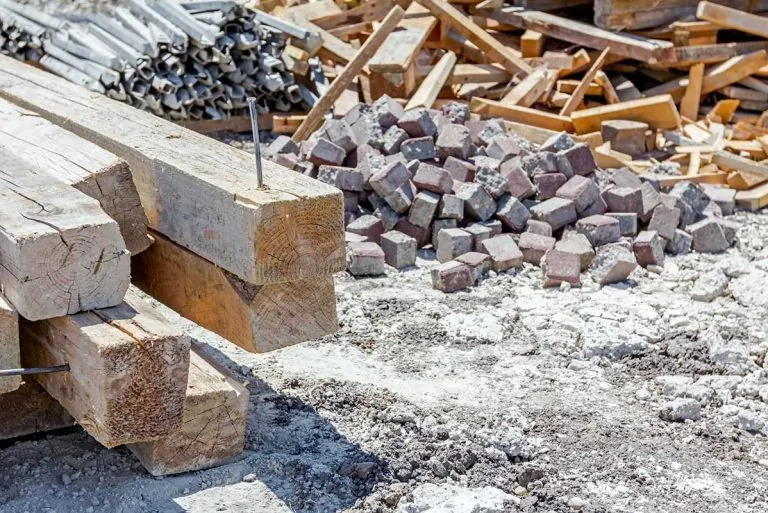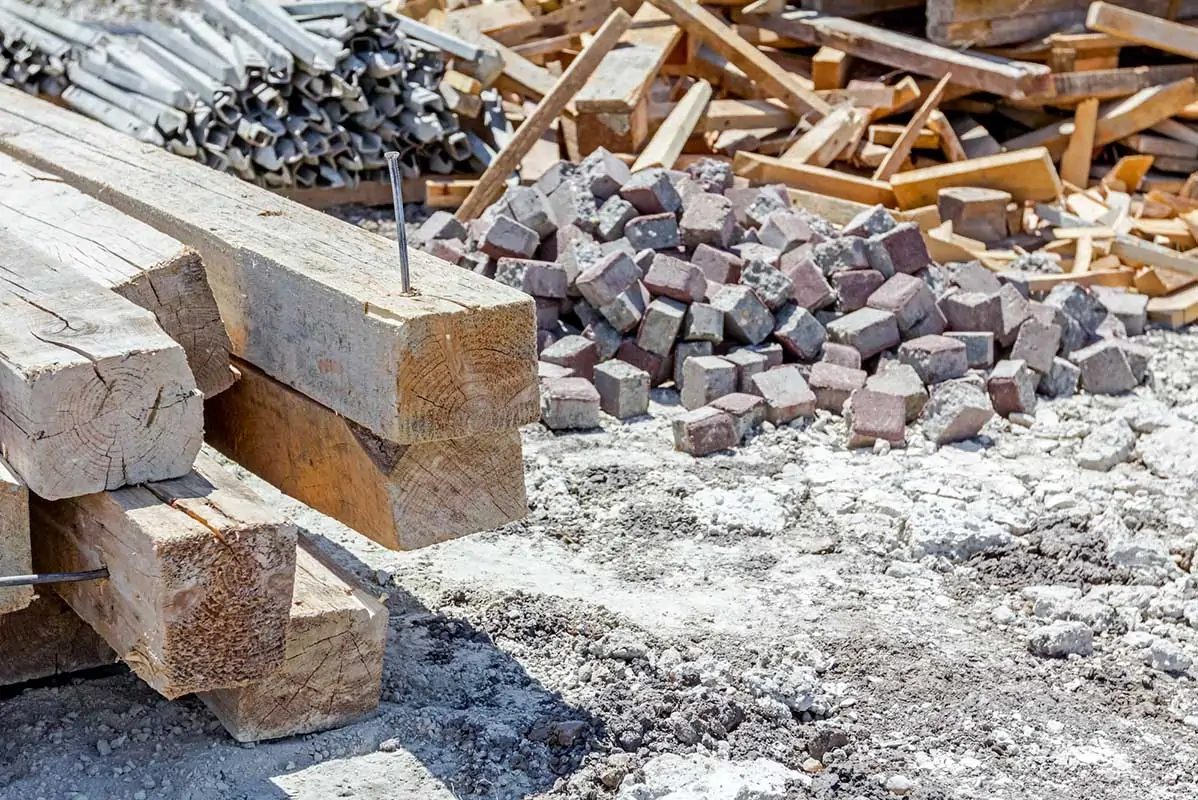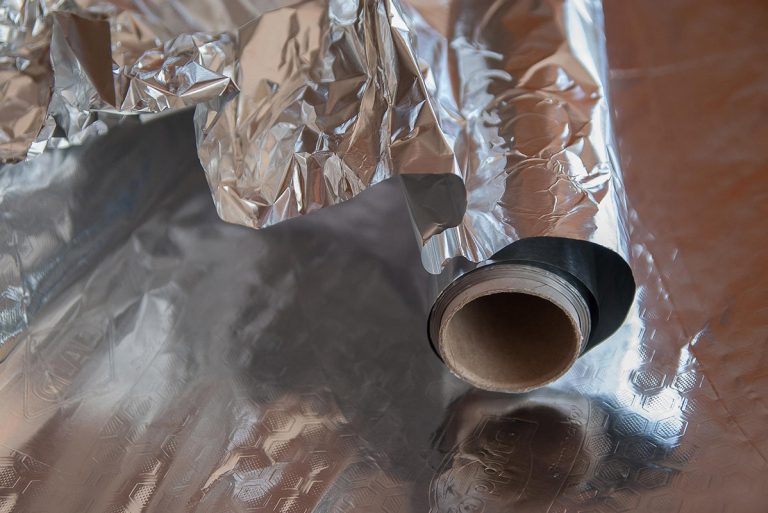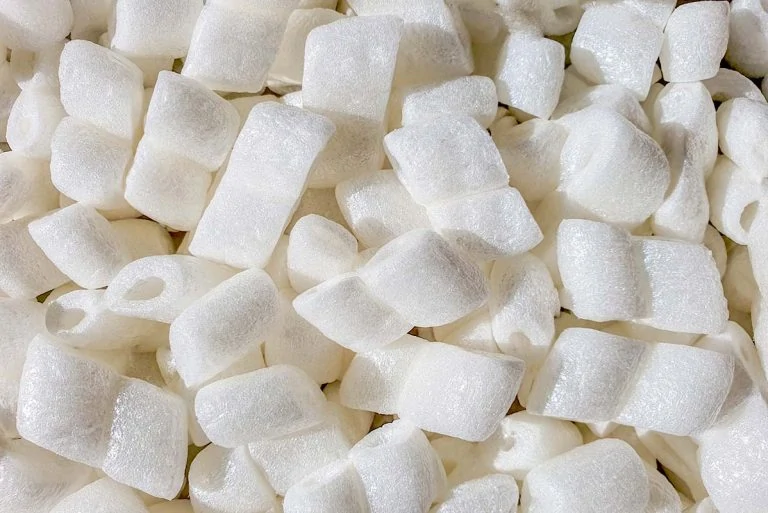Are you looking for ways to make your home more sustainable but not exactly sure how to do it?
Maybe you’ve recently purchased a “dunger”: a crumbling, dilapidated house in desperate need of some serious TLC. (It’s actually a thing.)
As a major first step, using recycled building materials to fix up semi-derelict structures instead of channeling all your funds into brand new abodes will drastically lower your environmental footprint — and reduce your overall costs.
The problem is knowing what to look for, and where to find it. In this article, you’ll discover all the essential information you need to build or renovate your eco-home using recycled building materials.
And when your project’s finished, you’ll rest easy knowing that you diverted some of the 600 million tons of construction-related waste generated annually in the United States from winding up in landfills already bursting at their seams.
What are recycled building materials?
Recycled building materials is a very loose term that includes all components of buildings, roads, or bridges repurposed to construct or renovate other buildings or structures.
The term ‘recycled building materials’ usually refers to concrete, asphalt shingles, steel, wood, glass, drywall, and flooring. It could also refer to lighting and bathroom fixtures, furniture, door and window frames, and similar objects.
Why should I use recycled building materials?
There are various advantages to using recycled building materials. These include:
- Cost savings – It’s cheaper to buy used versus new almost all the time. (Wood is the big exception.)
- Lowered environmental impact – No initial high energy inputs during extraction of natural resources and manufacture as required to make virgin materials.
- Easier permitting process – Some municipalities have limits on landfill waste and carbon emissions associated with construction materials. They also have sustainability goals. They’ll love you using recycled materials!
- LEED certification – Homeowners and builders alike may enjoy the greater facility to earn high marks from the U.S. Green Building Council when using lots of recycled building materials.
- Tax breaks – Check out all levels of government for freebies and other incentives to use recycled materials. Green building loans and grants are available in some places, too.
How much solid waste is generated from building construction and demolition?
Almost 25% of the U.S. waste stream is from construction and demolition (C&D) of buildings (homes and businesses), roads, and bridges.
In terms of the concrete and asphalt portion of that waste stream, 85% or more is recycled.
For steel, it’s even better: 98% is recycled!
However, 10-20% of C&D waste is considered “mixed C&D”. According to the U.S. Department of Transportation, this waste stream only has a 35% recycling rate. The U.S. Environmental Protection Agency lists this hodgepodge of building waste as “wood, drywall, asphalt shingles, bricks, and clay tiles.”
This is the portion that individual homeowners can capture and reuse in their eco-homes. In effect, they’ll boost the overall recycling rate of building materials while diverting them from landfills!

Unbelievably, up to 30% of all building materials delivered to a worksite can end up as waste. Since they’re almost all brand new, virgin materials, it’s no exaggeration to say that all the energy and water used to manufacture them are completely wasted.
At a time when fossil fuel energy production is accelerating our climate crisis and water becomes scarce everywhere in the American West due to exceptional drought, it behooves everyone to conserve natural resources in every way possible. Using recycled building materials is a significant way that individual homeowners can contribute to a greener world.
What are the main types of recycled building materials?
There are seven main types of home building materials used today. They are not all used equally to construct private residences, but usually have some role to play. Their prevalence in certain parts of the country varies depending on numerous factors, including cost, availability, and climatic conditions.
1. Wood
As the second largest segment of C&D refuse (after concrete), wood makes up 20-30% of this solid waste stream. Similarly, a measly 17% of wood pallets, available to be reused as building material, are actually reused or recycled somehow.

Thus, there is a huge potential to capitalize on wood as a recycled building material. In fact, it’s estimated to be over 17 million tons of wood per year. This wood is commonly called reclaimed wood.
Individual homeowners can get involved by picking up the sustainability mantle and breathing a second life into nature’s wood bounty.
However, compared to other types of recycled building materials, reclaimed wood usually sells for a premium because of the labor-intensive nature of removing nails and other steps of wood prepping, to get it ready for your project.
2. Steel
The great news is that practically all of the steel frames of non-residential buildings are recycled. In homes, steel occurs embedded in concrete as bars called rebar.

According to The Steel Recycling Institute, more than 65% of rebar is recycled. Demolition crews crush the concrete surrounding the rebar and extract the rebar with specialized equipment.
Every year, more than 7 million tons of “scrap” steel is reformed into rebar, saving substantial energy expenditures. For example, making one ton of new rebar would take 2,000 lbs. of ore, 1,400 lbs. of coal, and 120 lbs. of limestone.
But given the 65% number, there’s more that can be done to bring that value up. Homeowners can seize this opportunity.
3. Concrete
The Construction Materials Recycling Association estimates that in the U.S., approximately 140 million tons of concrete are recycled from the 375 million tons produced by C&D every year.
This number included, as previously mentioned, the pulverized concrete left after rebar extraction. The concrete can, in some cases, be reused for new building foundations, breakwaters, granular fill for roads, highways, or runways, landscaping walls, or new pavement.

Source: Wikimedia / Jim Bain
A unique problem to concrete recycling — that steel recycling, for example, is not subject to — is the presence of many different chemical additives, some of which may be hazardous. The difficulty in separating them means the concrete cannot be upcycled into products of greater value.
When recycling concrete, it’s also necessary to remove other components to the original concrete mixture, including gypsum, mortar paste, and plastics, if your goal is to recover “pure” concrete.
Recyclers may allow for the presence of these substances in what’s known as “recycled concrete aggregates” (RCA). These forms of recycled concrete are downcycled into the ways described above.
4. Asphalt shingles
Approximately 11 million tons of asphalt shingles are removed from roofs in the United States every year and replaced, usually with virgin asphalt shingles. Only 10% of those 11 million tons is recycled into roads projects or paving.

Source: Wikimedia / Christina Plati, Andreas Loizos, Vasilis Papavasiliou, Antonis Kaltsounis
Since asphalt is largely formed from petroleum, a fossil fuel, shingles are meant to last a long time. Thus, they do not easily degrade. They lay unchanged in landfills, probably for hundreds of years.
Until this year, when GAF, a U.S. company, began piloting a process to use used shingles to make new ones containing 15% of recycled asphalt. They have ongoing plans to increase the percentage of recycled content.
If successful, recycled asphalt shingles will alleviate a huge burden on landfills, some of which now ban shingles completely.
5. Flooring
Hardwood flooring is usually cheaper than virgin wood flooring, at least when you’re comparing the same type of wood. And flooring is one of the most popular materials to be recycled in homes.
All other types of flooring do not fare as well.
For instance, PVC (that is, vinyl) floors are so cheap to produce from methane gas that it’s difficult to deconstruct an existing floor and transplant it into your home unless you’ve located it before demolition and hire a professional who can remove it correctly.

Also, since vinyl degrades and cracks up easily over time, the product may not make it through a deconstruction process.
And I haven’t even mentioned the often toxic adhesives, sealants, and other chemicals, making the recyclability of flooring difficult at best and impossible at worst.
In terms of carpeting, the recycling stats are abysmal. According to a 2016 report, only 5% is recycled. Of that, only 20% is turned back into carpeting. The rest of the 5% is downcycled into stuff like plastic flower pots or park benches.
By contrast, the large majority (90%) of discarded carpeting is landfilled.
A few companies, like CarpetCycle, perform carpet recycling services.
Due to mixing with latex backing and foam cushioning underneath and the adhesives sticking them all together, it is extremely difficult to separate out the reusable “pure” nylon or polypropylene carpet fibers.
There are a handful of other companies, like Interface, that offer buyback programs and recycle used carpet that they then resell.
By the way, Interface’s founder, Ray Anderson, has had a considerable influence in advocating for “the business logic of sustainability” and will inspire anyone looking to create a sustainable home with recycled building materials. Have a listen to his TED talk.
6. Drywall
Also called gypsum board or sheetrock, drywall is ubiquitous in home construction projects. It’s commonly used in ceilings and walls.
Composed mostly of an earth mineral, drywall is simply gypsum sandwiched between two sheets of paper. Couldn’t be easier to recycle, right?
Sadly, in most demo projects, drywall is ripped out, torn up, and thrown away. Part of the reason is that it may be “contaminated” with paint, joint compound, tape, nails, screws, fasteners, and other unwanted, difficult-to-remove objects, and, so, not appropriate for recycling.
There’s also the fact that there’s a lot of gypsum board wasted during new construction. For example, it’s estimated that building a 2,000-sq.ft. home generates one ton of drywall scrap waste! That’s about 10% of all drywall used to build a house.

Most of that consists of irregularly-shaped pieces but they’re more likely to be recycled than demolition waste.
Recyclers prefer “clean” materials. So they tend to recycle the gypsum produced from coal-fired power plants. Most of this recycled material goes toward making new drywall. It may also be used to make cement or added to soil as an amendment.
Some municipalities in the U.S. and Canada do not permit drywall to be landfilled. They’re concerned about the production of hydrogen sulfide gas (rotten egg smell) which could react in air to form sulphur dioxide or sulfuric acid, both of which are harmful to human health and the environment.
Drywall leaching in a landfill could also result in an unwelcome pH change to groundwater. More the reason to recuperate what drywall you can and reuse it in your eco-home.
7. Glass
Like steel as a recycled building material, glass is infinitely recyclable if it is“pure” (that is, no chemical additives), single pane, and clear.
Unfortunately these days, there’s not much “flat” glass used in building construction – except in windows, doors, and countertops.
As a result, treated glass, insulated glass, colored glass, and any other specialty glass is almost always landfilled. What is recycled is downcycled into fiberglass insulation or sometimes used as a cement additive (although final product quality is questionable).

Source: Flickr / keeping it real
Coupled with the low rate of glass container recycling in the U.S. (33%), sending glass to the landfill instead of recycling is a monumental waste of natural resources.
In fact, reusing cullet — the industry’s name for recycled glass — to make new products is 30% less energy intensive and produces 37% less carbon emissions.
But yet, glass recycling is not as commonplace as it should be in a sustainable economy.
As a green homeowner, reusing stained or colored glass in a decorative fashion saves landfill space as well as natural resources. Or, if the look of a glass countertop appeals to you, companies like IceStone create them from recycled glass (up to 70% by weight).
What’s the difference between reclaimed and recycled building materials?
In many cases, when it comes to building materials, reclaimed and recycled are used interchangeably. The terms are often used to refer to reusing something in the same fashion but a different location, or using it for a purpose other than its original one.
However, it’s only when an item has not undergone any change before its reuse that it’s said to be reclaimed.
For example, hardwood flooring from a demolition site that was carefully removed as is and installed as flooring in a new construction can be described as reclaimed.

Source: Wikimedia / John M.
There is a specific meaning to recycled in relation to building materials that the word reclaimed lacks. It involves mixing a percentage of used to new material and forming recycled products.
For instance, consider any one of the seven major types of building materials: shingles, steel, wood, concrete, glass, drywall, or flooring. If a sample taken from an existing property has been completely separated from other substances embedded in it (like nails) and then pulverized, it has been put in a “like new” form.
Adding the “like new” substance to identical fresh material (like mixing a small amount of used, crushed shingles to virgin asphalt) results in what’s correctly called recycled shingles.
Creating an entirely different product (like sawdust glued and pressed into particle board) also results in a recycled item. In this case, the wood ground down into sawdust is likewise referred to as recycled wood.
Are sustainable building materials the same as recycled?
There are many different types of building materials that can be considered sustainable or eco-friendly. Among them are recycled materials.
Using recycled building materials is always preferable to using brand new ones. Virgin materials require extraction of more minerals — along with environmental destruction to get to them — as well as high-energy inputs to manufacture. Recycled materials do not have such requirements.
Waste materials from demolition sites or salvage yards are another type of sustainable building material. If not intercepted by eco-conscious homeowners or contractors, these items would be on their way to the dump or incinerator.
There are a number of innovative building materials that are sustainable. Here are a few examples:
1. Timbercrete
Made primarily from sawdust and concrete, timbercrete is an alternative to concrete, one of the most carbon-polluting substances humans have ever invented. Other uses for timbercrete is in fencing.

Source: Timbercrete
2. Ferrock
Created from waste steel dust and silica, the iron in the steel chemically reacts with carbon dioxide in the air, forming iron carbonate.
Not only is ferrock five times stronger than conventional concrete, it absorbs rather than emits carbon dioxide (like concrete does) as it dries. In other words, ferrock is carbon-negative. This makes it ideal in a world that drastically needs to go carbon negative to maintain a semblance of a livable planet.
3. Ecobricks
No one would dispute that human fossil fuel reliance has created a huge plastic pollution problem. Ecobricks aims to lessen the impact of plastic as an environmental pollutant by compressing them into bricks that can serve as a building material.
Here’s a short video that explains the process. You can even try your hand at it. Give it a try!
4. Recycled cork
Cork is an extremely sustainable material most commonly associated with fine wine (bottles!) Trees continue to produce cork throughout their lifetimes.
Today, cork’s popularity as an eco-insulation is growing worldwide.
Cork may also be used as a building material, including flooring, and wall and ceiling coverings. Cork is insulating as well as stylish when used in these ways.
Check out this directory at Cork Forest, where you can drop off your cork stoppers for recycling.
Where can I buy recycled building materials?
Fortunately for people looking to live more sustainably, there are plenty of places where you can purchase recycled building materials. However, if you’re looking for something very specific, some of the following options are better than others.
1. Best all-around source of recycled building materials
Identifying through local or state government websites or agencies which buildings are scheduled for demolition in your region will give you time to contact the demolition companies.
You may inquire about the types and quantities of building materials available. If there is no planned separation by material type, or no careful deconstruction (of drywall, for example), you may wish to see if you could hire professionals to do this work for you.

By investigating several planned demolitions, you will likely find everything you need for your own project… and the next one, too!
2. Best for reclaimed wood
There’s nothing like full-bodied and fine textured wood to add depth and ambiance to your home. Knowing its particular story gives you bragging rights, too.
Today, reclaimed wood dealers are cropping up all over the place. They are proud of their high-quality handiwork completed to your exact specifications, from prepping each piece they sell you to meet all of your project’s needs and then some.
If you’re after an exotic tree species, there are some who ship long-distance. Others rely on locally-sourced wood from common tree varieties and sell only locally.
For a complete listing of reclaimed wood companies, the directory at Reusewood can’t be beat.
3. To support a good cause + get recycled building materials
Habitat for Humanity (HfH) is a nonprofit organization founded in the United States in 1976 and currently in more than 70 other countries as well. Its mission is to provide affordable housing to underprivileged people everywhere.
HfH relies on recycled building materials as well as donations of new materials. Excess is sold through their local ReStore stores.
There is an online directory of stores that will give you some locations to investigate on your sustainable home journey.
4. Hit or miss recycled building materials + antiques
Although there are exceptions to every rule, salvage yards usually offer a mish mash of recycled building materials. A lot depends on their space, organization, and turnover rates.
It is possible to get lucky at salvage yards since they function like specialty thrift stores. So, it’s a good idea to check back frequently.

Besides the major types of recycled building materials, it’s also possible to find a variety of unusual fixtures, antique bathroom sinks and bathtubs, doorknobs, or furniture, to name just a few. But some salvage yards listed in this online directory may be very small and limited in their offerings.
5. General directory for recycled building materials
As general interest in sustainable living grows by leaps and bounds all the time, more resources become available to assist in the process. One excellent online directory is RecycleNation.
If you’re lacking local demolitions, RecycleNation may be the next best place to continue your search for recycled building materials.
Hot takes on recycled building materials
If you’re aiming to build or renovate your home to make it more sustainable, it’s a no-brainer to include one or more major types of recycled building materials in your plans.
In general, you will save a lot of money while diverting mostly recyclable materials from landfills. In the process, you’ll be indirectly responsible for conserving energy, water, and other natural resources needed to create virgin building materials.
There is a wide variety of places to search for and locate all sorts of recycled building materials. So what are you waiting for?













